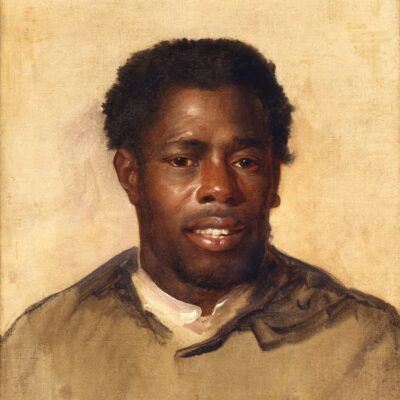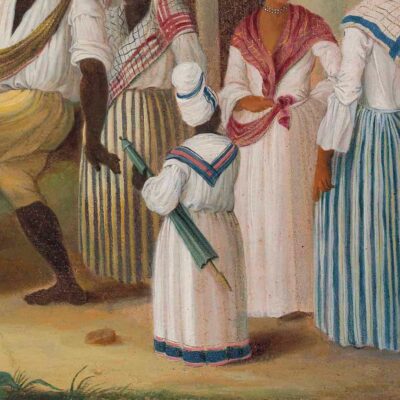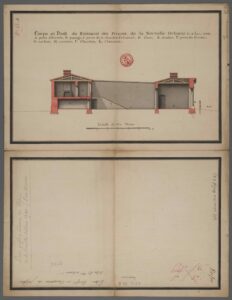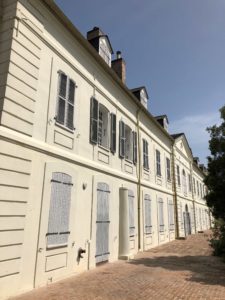Marguerite, 1764
A woman from the Congo showcases her perception of Catholicism and of enslavement
CommentaryIn 1764, Marguerite, a twenty-five-year-old enslaved African, was charged with fugitivity after running away from her master and brought before the Superior Council of Louisiana in New Orleans. She was first made to swear an oath to tell the truth before a crucifix and to identify herself to the court; then her interrogation began. Though she was the defendant in a criminal case, Marguerite placed the blame for her actions on her owners, complaining that she had become a fugitive three weeks earlier because “her master and her mistress always beat her, that [when] she was ill, her mistress having come to see her after four days, she said to her, ‘Mademoiselle is playing at being ill, is she?’ and right then beat her with a stick, made her work and clear the courtyard, and threatened that if she did not go to work that she [Madame Dufossat] would call the negres to take her to the public square to give her a hundred lashes of the whip” (Son Maitre et Sa maitresse la battaient toujours quell Estoit Malade et que Sa maitresse Etant venü voir au bout de quatre jours Elle luy dit Mademoiselle se fais la malade es que dans Linstant Elle Luy donna des coups de baton, et l’envoya travaillé et defriché dans La Cour. et qu’elle La menacee que Si Elle n’estoit pas travailler quelle alloit appeller des negres pour la Conduire Sur la place pour luy faire donner cent Coups de fouët). Marguerite concluded her narrative by adding to her list of grievances that “every evening, they had locked her up like in a convent” (tous les soirs ils la faisoient Renfermé comme dans un Couvant).1
The Court Case
The Court CaseMarguerite was being prosecuted for running away, yet in court, it was she who leveled an accusation against her owners. Was her testimony tactical? The court did not investigate her claims of abuse or her mistress’s threat of a public whipping. Rather, it ruled that she be returned to the home of her master, Mr. Guy Dufossat, a retired captain in the Marine, and his wife, Françoise Claudine Dreux, where she undoubtedly suffered more abuse. Her masters would not have been in the courtroom during her testimony, though it’s likely that what she said leaked out to them. Sentences for marronnage (running away) were mandatory only for those who had absconded for longer than a month. This was not the case here (perhaps Marguerite knew this and planned to return before the month was out), but the Superior Council nevertheless convicted her of running away and sentenced her to have her ears cut and to be branded with a fleur-de-lis (a stylized lily that was the symbol of the French crown) on her right shoulder (Figure 1).2
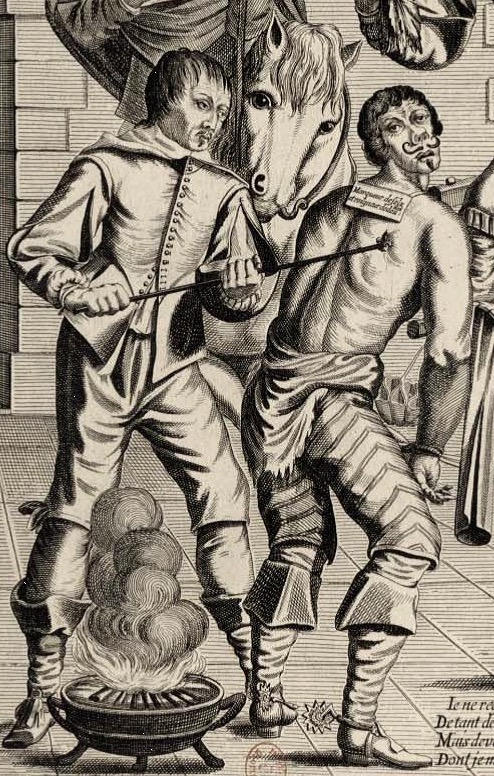
Figure 1
Detail from Histoire veritable et facecieuse d’un Espaignol lequel à eu le fouet et la fleur de lis dans la ville de Thoulouze pour avoir derobé des raves et roigné des doubles . . . 1630. Richelieu. Département Estampes et photographie. RESERVE QB-201 (27)-FOL . Courtesy of Bibliothèque nationale de France, Paris
In this rare depiction of a judicial branding, we see a hot iron shaped like a fleur-de-lis being applied to the right shoulder of a convicted criminal in 1630 France.
The trial’s outcome notwithstanding, in Marguerite’s testimony we see not only glimpses of her pain and her sense of outrage but also flashes of her personality, character, and sense of humor. Her narrative allows us to glean the dual ways she chose to respond to the abuse. She did so, first, with her feet, by running away, specifically to the cabin of a male slave, Janot (also spelled Jeanot), who was in all likelihood her lover, or at the very least, a source of kinship, of emotional and material support (Figure 2). She identified him as Congo, like her. Janot’s owner, Joseph Villars Dubreuil, was the son of the largest slaveholder in the colony, and the plantation where Janot lived was situated a few leagues downriver from New Orleans, requiring Marguerite to make her way some distance in order to reach him. It was the enslaved overseer (the commandeur) on Dubreuil’s plantation who had her seized, dispatching his son to return Marguerite to her master Dufossat. Dufossat in turn had her taken to the prison (Figure 3). Second, she signaled her displeasure verbally, in the particular manner that she conveyed her disapproval of the way her masters treated her and her anger at their lack of fairness.3

Figure 2
N[icolas] de Fer, L’afrique, ou tous les points principaux sont placez sur les opservations de messieurs de l’academie royale des sciences, 1761. Département cartes et plans. GE D-11409. Courtesy of Bibliothèque nationale de France, Paris
Map of Africa by N[icolas] de Fer, 1761.
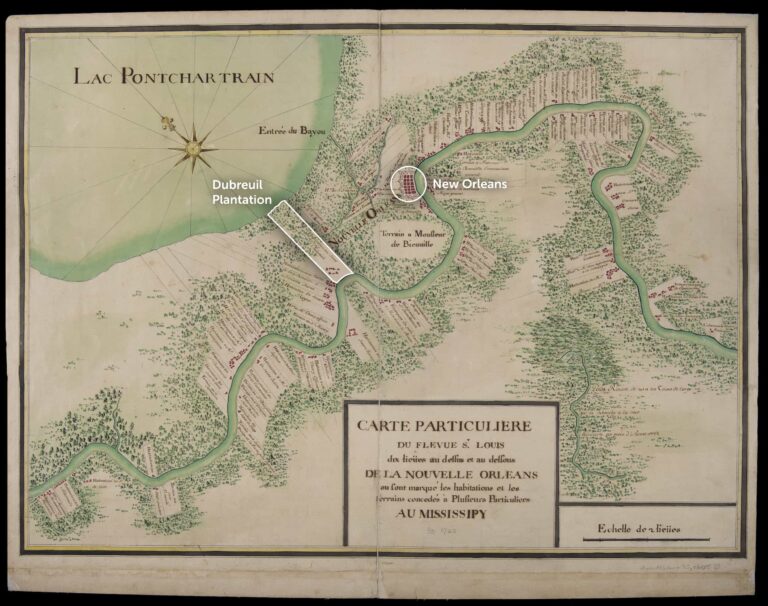
Figure 3
Unknown artist, Carte particuliere du flevue [sic] St. Louis dix lieües au dessus et au dessous de la Nouvelle Orleans u sont marqué les habitations et les terrains concedés à plusieurs particuliers au Mississipy. Circa 1723. Edward E. Ayer Manuscript Map Collection. VAULT drawer Ayer MS map 30 sheet 80. Courtesy The Newberry Library, Chicago
This French map from circa 1723 shows the course of the Mississippi River (then known by the French as the Saint Louis River), delineating the various tracts of land and habitations of the French on both sides of the riverbank up and downriver from New Orleans. Note the distance between New Orleans and the Dubreuil plantation where Marguerite was captured.
Madame Dufossat might have thought she was making fun of Marguerite, sardonically calling her “Mademoiselle” (Miss) and using the third person to address her slave (“Mademoiselle is playing at being ill, is she”) in the same way that a servant, following convention, might address the person they were waiting on. But, in court, it was Marguerite who used her biting wit to mock her mistress, making fun of her behind her back by mimicking her words and tone. In doing so, was Marguerite invoking a long-standing West African tradition of using humor to outwit an opponent? Marguerite further critiqued the behavior of the Dufossat-Dreux couple with a simile referencing New Orleans’s Ursuline convent (“every evening, they had locked her up like in a convent”). Although court procedure required her to identify herself and, as an enslaved woman, to provide the name of her owner, she also volunteered that she was “of the Congo nation,” stating that “she is named Marguerite, belonging to M. Dufossat, former captain, aged twenty-five years old, of the Congo nation” (a dit Sappeller Marguerite appartenant a M. dufossat ancien Cap.ne agéé de vingt cinq ans de nation Congo). She evidently grasped the fundamental notion of cloister and of a Catholic model of celibacy, mediated by architecture, that segregated women from men. But this African-born woman, who had been captured, shackled, enslaved, and confined in cramped quarters on board a ship during the Middle Passage, likely could not fathom that cloistered nuns volunteered to be “locked” up (Figure 4).4
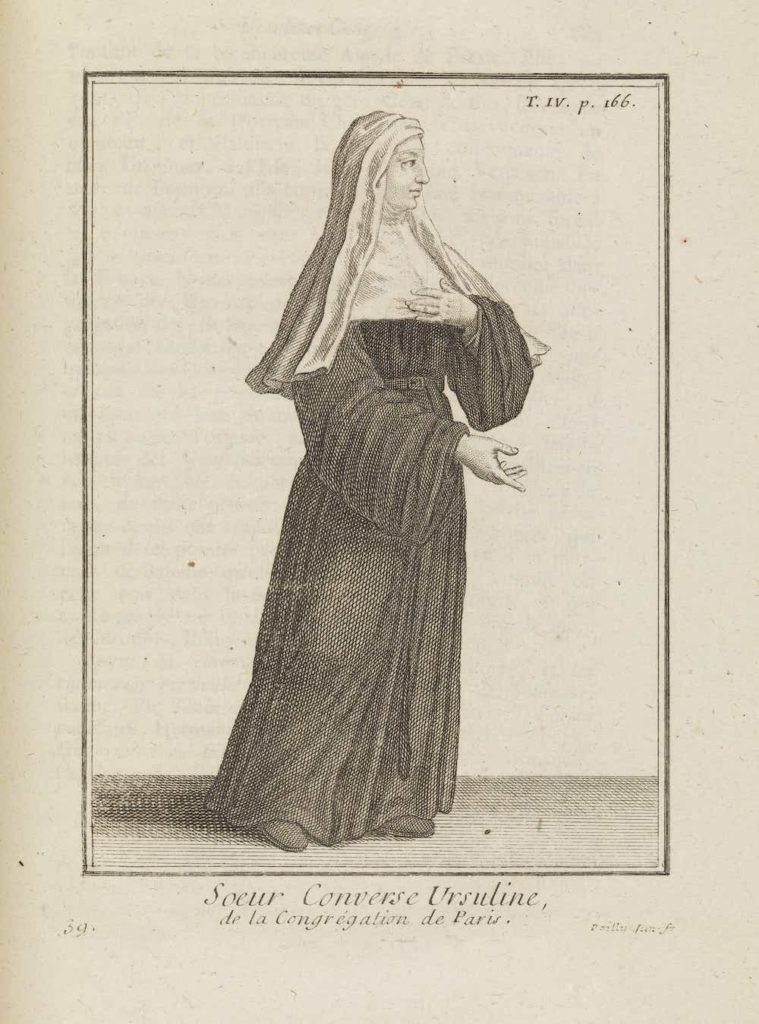
Figure 4
Soeur Converse Ursuline de la Congrégation de Paris. From Pierre Hélyot, Histoire des ordres monastiques . . . , IV (Paris, 1715), x. Wellcome Collection: CC BY. London
They Locked Her Up Like in a Convent
They Locked Her Up Like in a ConventDid Marguerite speak the truth? Had her mistress said those very words to her? We cannot know for sure, and perhaps we do not need to know. What we can say is that Marguerite answered the judges’ questions and made an assertion about what she considered egregious in the way her mistress and master treated her, adding a flourish of sarcasm to her tale as she gave an answer that was anchored in her own experience, personality, and ways of knowing, one that was autobiographical because it expressed how she looked at her world, evaluated it, and made sense of it at that moment in time. It was Marguerite, not her interrogators, who spoke of being “locked up,” and it was she who employed a simile to critique her masters’ control of her sexuality—even using humor to do so. It was she who seemed genuinely put out that her masters did not treat her as she seemed to expect, for she surely had knowledge of, and had internalized, what it could mean to be a slave in West Central Africa, where the concept of slavery allowed for a more flexible range of practices in the treatment of captives. It was also she who described the forced intimacy created when her masters asserted physical and emotional control over her, making fun of her when she was ill, beating her and locking her up, but also threatening to have her whipped in public. A slave was supposed to submit, emotionless, to the constraints and violence inherent in such words and actions (and to be contrite if he or she failed to do so in the moment). Marguerite countered both expectations, by running away but also by making a point, in court, of explaining her reaction and laying out her argument.
To understand how Marguerite experienced the cityscape and her place within it, we must first comprehend the built environment of New Orleans (Figure 5). When she offered the simile of being “locked . . . up like in a convent” as one motive for running away to the cabin of her male friend, she had literally just been locked up, but in the town jail. How did that experience affect her choice of comparison, especially given the absence of these institutions in West Africa? The prison was located on the Place d’armes (present-day Jackson Square), to the right of the Church of Saint Louis when facing the quay (Figures 6 and 7). But the prison complex was not just reserved for locking up those being prosecuted and those who had been convicted. It also contained the criminal chamber where special interrogations “on the sellette” (so named for the low stool on which the defendant was made to sit) and judicial torture were carried out and recorded (Figure 8). A large space, the room measured approximately four by three toises (approximately nineteen by twenty-five feet). Regular interrogations took place in the chambers of the Superior Council, which would have required a defendant to be led out of jail and taken under guard around the block.5
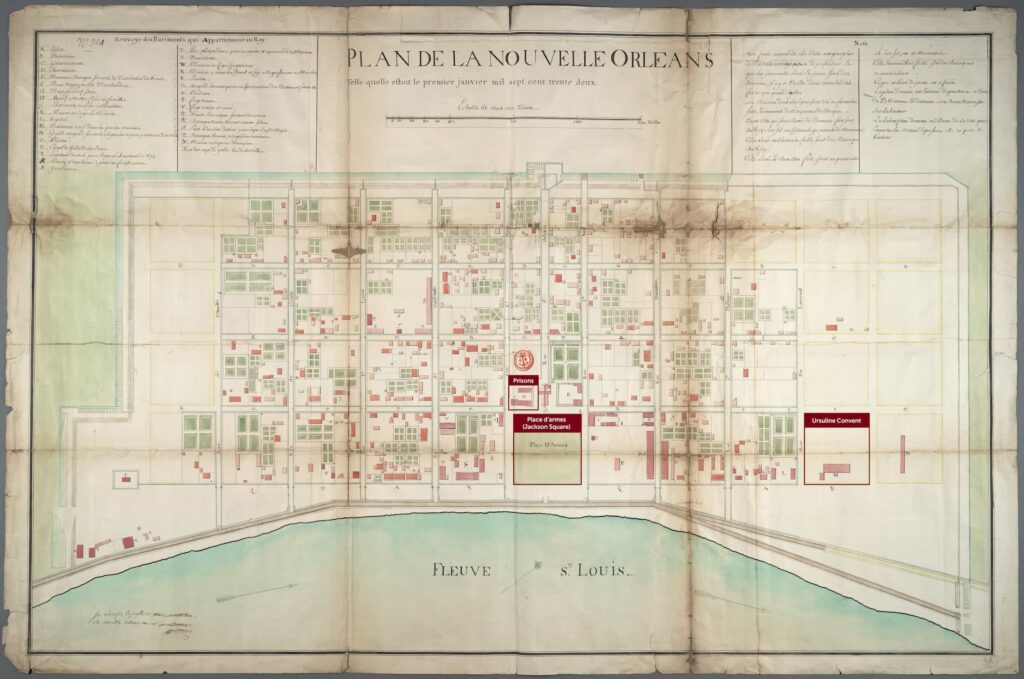
Figure 5
[Ignace-François] Broutin, Plan de la Nouvelle Orléans telle qu’elle estoit le premier janvier mil sept cent trente deux. Jan. 20, 1732. FR ANOM 04 DFC 90 A. Courtesy Archives nationales d’outre-mer, Aix-en-Provence, France.
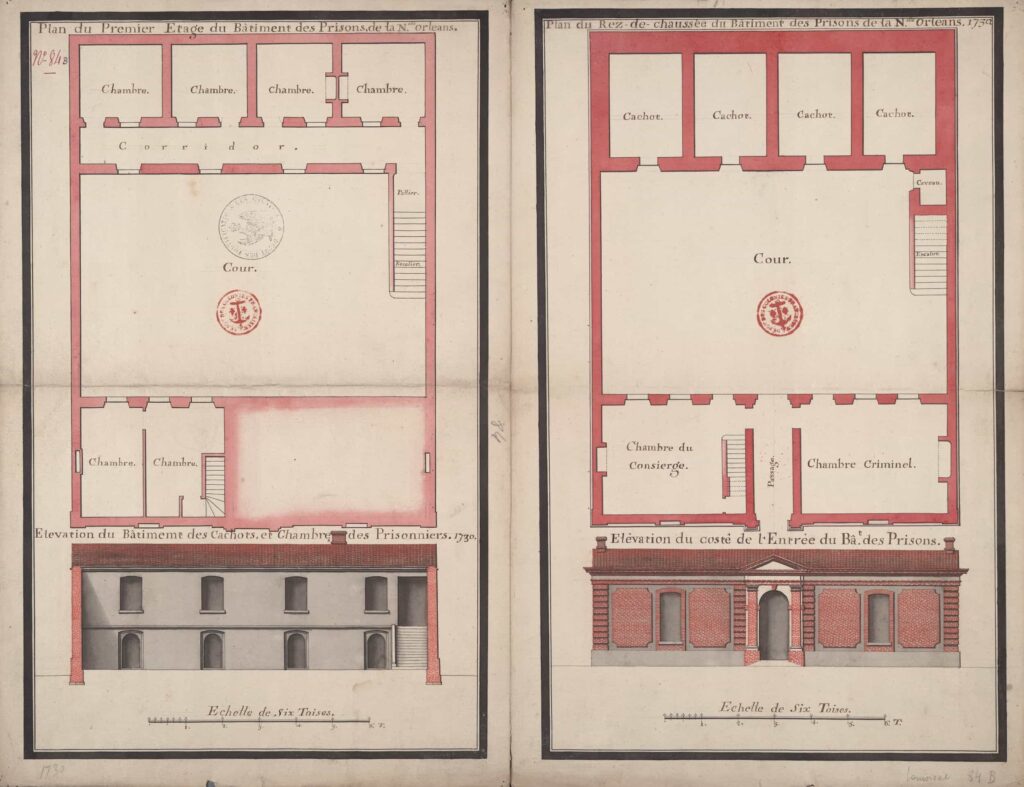
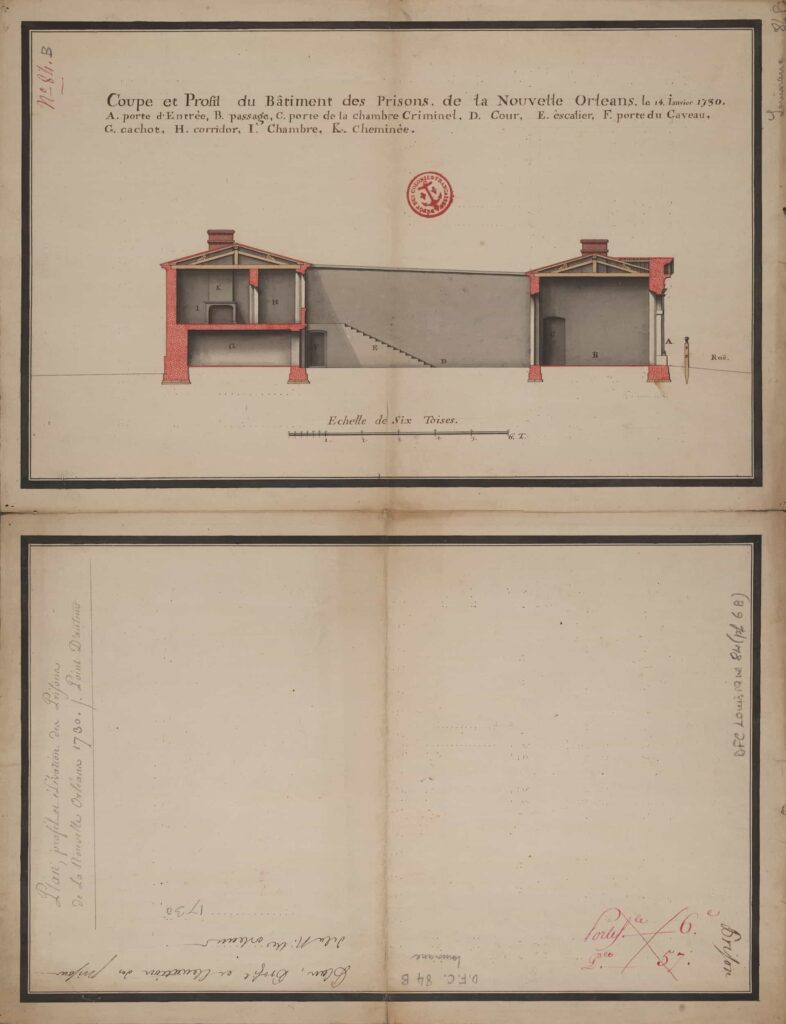
Figures 6 & 7
Anonymous, Plan, profil, et elevation des prisons de la Nouvelle Orleans, 14 Janvier 1730. Watercolor. FR ANOM 04 DFC 84 B. Les archives nationales d’outre-mer, Aix-en-Provence, France
The prison was the first major building constructed of brick without a timber frame, covered in masonry. Two stories high, consisting of two separate buildings linked by a walled-in courtyard for the use of prisoners, it measured about six by eight toises (approximately thirty-eight by fifty-one feet). Each cell (on the upper level) measured about two-and-one-half by two toises (approximately sixteen by twelve-and-a-half feet), meaning that these were communal cells.
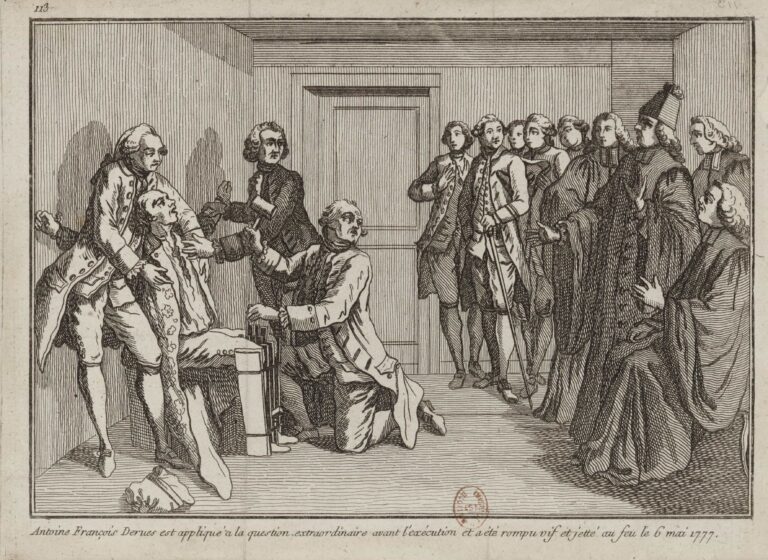
Figure 8
Unknown, Antoine François Derues est appliqué à la question extraordinaire avant l’exécution et a été rompu vif et jetté au feu le 6 mai 1777. From Portrait de Desrues et quarante planches relatives à la vie, aux crimes et à l’exécution de ce scélérat. 1777. Engraving. Département Estampes et photographie. RESERVE QB-201 (110)-FOL. Courtesy of Bibliothèque nationale de France, Paris
In this engraving from a set about an infamous French court case, the accused is shown being interrogated on the sellette, or low stool.
That Marguerite had spent time in prison, however, was just one element of her narrative. She specifically mentioned that it was her master and mistress who had locked her up. Dubreuil’s overseer had her taken to Gentilly, just outside New Orleans, but her knowledge of the convent and her reference to a courtyard suggests that her owners also had a residence in the city. Though we do not have information on where their residence was located, the architecture of New Orleans allows us to speculate about her experience. When Adrien de Pauger designed New Orleans in 1722, he laid out the city according to a straight grid anchored by the Place d’armes, with residential lots “of such a size that each and every one may have the houses on the street front and may still have some land in the rear to have a garden, which here is half of life.” In other words, the town house lots consisted of dwellings set right on the street with rear courtyards, like the one that Marguerite was made to clear (Figure 9).6
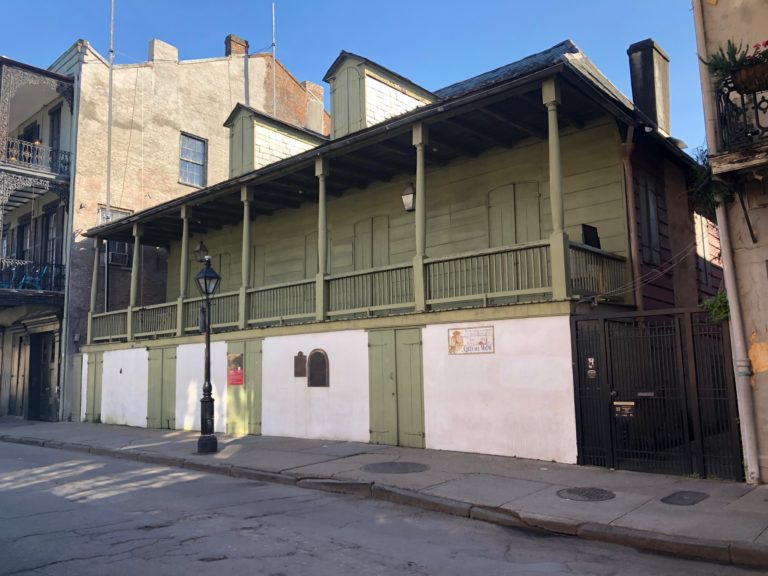
Figure 9
Madame John’s Legacy. 1788 with later additions. 632 Dumaine Street, New Orleans. Photo courtesy of Philippe Halbert
The ground level of this eighteenth-century residential building complex in the French quarter, now known as “Madame John’s Legacy,” was used for commerce and storage, the upper levels were residential, and the rear walled-in courtyard could be accessed either via the house or through the narrow side gate. For more information on the site, see https://louisianastatemuseum.org/museum/madame-johns-legacy
Courtyards were utilitarian, containing vegetable gardens for household use and perhaps housing for the enslaved, but they were also spaces of leisure for the master and mistress of the house. When the elderly Dame Elizabeth Real, Widow Marin (owner of the so-called Madame John’s Legacy house), composed her will in 1769, the notary and his attendant had to wait on her at home. They “entered into the hall of the said House in which we have found the said [Dame] Widow Marin, seated between the two courtyard doors in the coolness, who seemed to us to be ill in body because of her great age, but sound in spirit, memory and understanding.” After Madame Dufossat beat Marguerite “with a stick, made her work and clear the courtyard, and threatened that if she did not go to work that she [Madame Dufossat] would call the negres to take her to the public square to give her a hundred lashes of the whip,” did she, too, like Widow Marin, sit in the shade watching over her slaves? Accessed from the street via narrow side gates, courtyards were generally invisible to passersby, thanks to the high walls that enclosed the properties. Travel accounts emphasized that slaves customarily enjoyed a degree of mobility within the town, but perhaps such statements were hyperbolic. A master who really wanted to control his slaves’ access in and out of these sealed off residences could do so, as Dufossat and his wife seem to have done with Marguerite. It might well have been unusual to confine one’s slaves in that manner, though, and if it leaked out from the trial that they had been so stringent in locking her away, perhaps the town’s rumormongers might have wondered why. As a result, the Dufossat couple might have felt pressured to change their ways, or been content to become the fodder for gossip, either way amplifying Marguerite’s disapprobation.7
Why did the Dufossats restrict her access quite so strictly, and were they more stringent than was broadly customary in New Orleans, or more so than what Marguerite might have anticipated? She was of childbearing age, and perhaps they saw her as a short-term investment, one whose labor they did not want to see disrupted by pregnancy. Maybe she had made a habit of running away before—she did, after all, know how to make it all the way to Janot’s plantation without being caught, though court officials did not probe whether he had assisted her in her journey. She could have been fleeing from sexual assault at the hands of her master, though the fact that she jointly blamed the Dufossat couple for locking her up would seem to temper that interpretation. Whatever the reason, it is clear that Marguerite objected to being confined so regularly at night and that she actively desired the cultural familiarity, the relative peace, and the pleasure she derived from being in Janot’s company.
Marguerite and Janot, Congo
Marguerite and Janot, CongoBoth Janot and Marguerite had undergone the brutal Middle Passage across the Atlantic that had conveyed them from capture in West Central Africa to enslavement in the New World. Approximately twenty-five years old in 1764, Marguerite could not have come to Louisiana on any known or sanctioned slave ships from the Congo, since the only slave ship documented to have come from that region was La néréide, which transported 294 enslaved persons from Cabinda (Angola) to the colony in 1721. There were, however, other ways, licit and illicit, for a colonist in Louisiana to acquire slaves, especially through trade with the French islands. Given that Marguerite had sufficient command of French not to need a court interpreter, she was in all likelihood not new to the French colonies but brought in from the islands after being forcibly conveyed there on a slave ship like La Marie–Séraphique, which left Loango (Angola) in 1769 crowded with 307 captives bound for Cap Francais in Saint Domingue (Haiti). A rare set of watercolors of La Marie-Séraphique‘s 1769 voyage has survived, showing the vessel’s plans, profile, and layout (Figures 10 and 11). The watercolors also include a complete set of tables recording every expense, from purchase and sale prices to the voyage’s overall profit from the sale of captives on the island. A close-up of the steerage shows the squalid, cramped conditions in which captives, separated by sex, lived during the crossing (Figure 12). The watercolors are so precise that it has been possible to produce a 3D-video reconstruction of this vessel in all its chilling detail. Marguerite and Jannot had traversed the Atlantic on such a vessel, and they had experienced its horrors. The ship on which they reached New Orleans is not known. Had they been brought to that colony on the same ship? Or had they met in Louisiana, either in town or at a dance on one of the neighboring plantations, recognized their common roots, and formed an attachment that withstood all attempts to keep Marguerite confined? 8
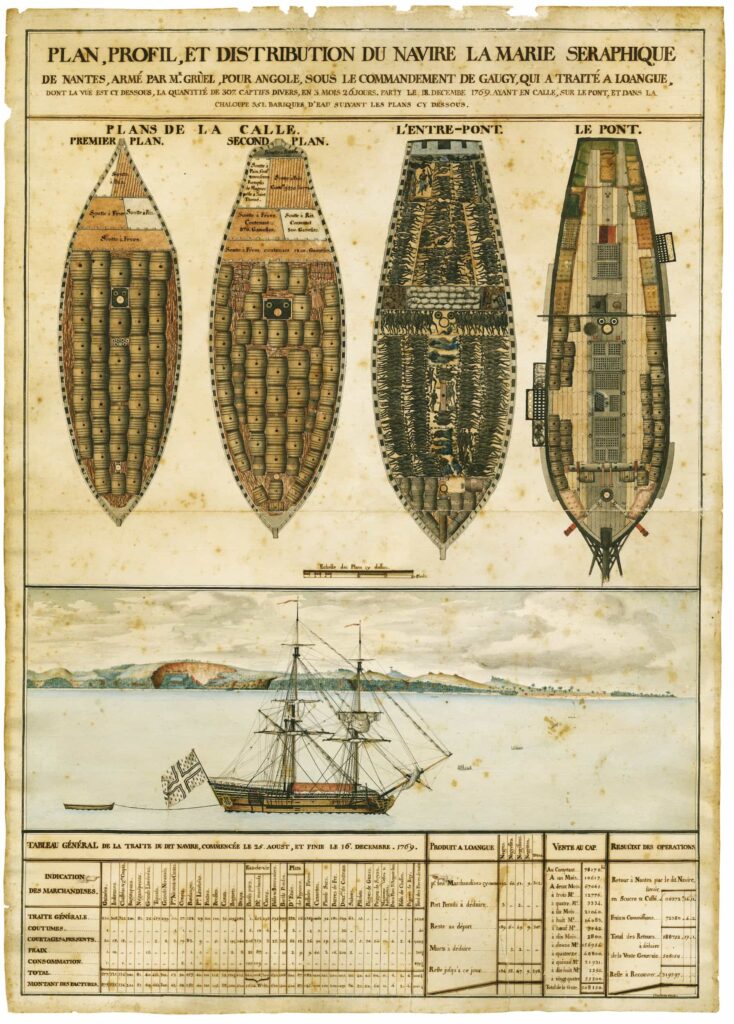
Figure 10
René Lhermitte, Plan, profile, et distribution du navire La Marie Séraphique de Nantes . . . , 1769. Acc. # 2005.3.1. Château des ducs de Bretagne, Musée d’histoire de Nantes, France

Figure 12
René Lhermitte. Vue de Cap Français et du nre. La Marie Séraphique de Nantes Capitaine Gaugy le jour de l’ouverture de sa vente troisieme voyage d’Angole, 1772–1773. Acc. # 950.4.3.2. Château des ducs de Bretagne, Musée d’histoire de Nantes, France
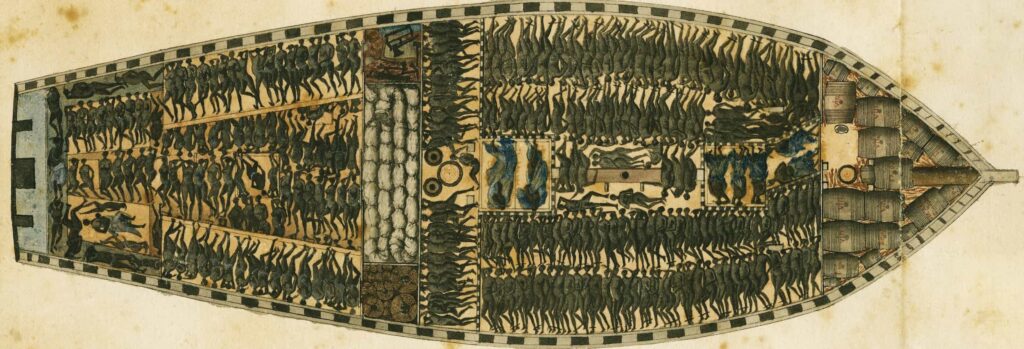
Figure 11
René Lhermitte, “L’entre-pont.” Detail from Plan, profile, et distribution du navire La Marie Séraphique de Nantes . . . , 1769. Acc. # 2005.3.1. Château des ducs de Bretagne, Musée d’histoire de Nantes, France
This set of watercolors of La Marie-Séraphique’s 1769 voyage from Nantes (France) to Loango in the Congo River region, and then to Saint-Domingue (Haiti), was painted by the ship’s second lieutenant, possibly while at sea. They offer the most accurate known depiction of a slave ship and slaving voyage during the eighteenth century. Accompanied by tables that document every transaction, the watercolors illustrate the ship’s layout and even include one scene showing the purchase of slaves at the trading post of Loango. Another portrays the sale of enslaved individuals aboard ship in Saint-Domingue (Haiti), the French male and female purchasers dining under a canopy while transacting business. A close-up of the steerage shows the horrific and cramped conditions in which captives, separated by sex, were locked at night during the ten-week-long crossing. For a 3-D reconstruction of La Marie-Séraphique, see https://www.slavevoyages.org/voyage/ship#3dmodel/0/en/
To plumb how Marguerite grasped the concept of cloistering (“locked up” like “in a convent”), particularly given that she identified herself as “of the Congo nation,” we also need one final piece of the puzzle—that there was an Ursuline convent right in New Orleans, the buildings visible, the nuns closed off, covered from head to toe (Figure 13). In fact, the daughter of Marguerite’s masters, Françoise Dufossat, would enter that very convent in 1773 to become a nun, suggesting that the household was a devout one that would have very likely sent Marguerite to the Ursulines for religious instruction. Though the ethnonym Congo was ambiguous in terms of her actual origin in Central Africa, it is in fact possible that it was there that Marguerite first encountered Christian concepts and imagery, since the kingdom of Kongo had converted to Catholicism in 1481 and missionaries were still present in the eighteenth century (Figure 14). Yet there were no female convents in the kingdom of Kongo, meaning that it was in the New World that Marguerite initially came into contact with this institution and first saw nuns. If she had come via Martinique, and specifically Saint-Pierre, she might have seen the convent there, which was the only one in the French Antilles. More likely, her earliest glimpse of nuns living in a cloister was in New Orleans.9
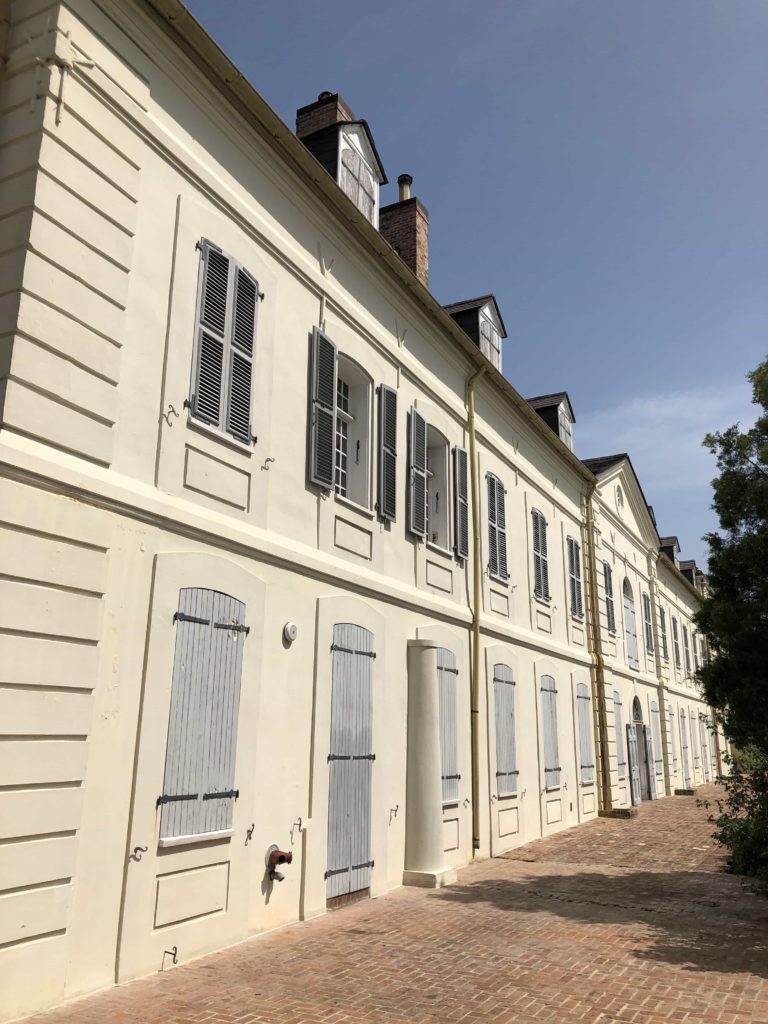
Figure 13
Ursuline Convent. 1745 and later additions. New Orleans, facing the quay. Photo courtesy of Philippe Halbert
For further views of the Ursuline convent building, including an aerial view, see https://oldursulineconventmuseum.com.

Figure 14
Unknown Capuchin artist. Missionary Father Who Does the Catechism; 1: Portable Altar but Closed 2: Father Who Catechizes 3: Catechumens 4: People Already Cathechized 5: Heathens Who Came over Out of Curiosity to Hear. The Parma Watercolors. PW096. Virgili Collection (Bilioteca Estense Universitaria), Italy. Photo: Cécile Fromont.
This understanding of Marguerite’s probable origins and the presence of an Ursuline convent in New Orleans helps us interpret her narrative and understand what it meant when, seizing the opportunity to voice her outrage, she expressed herself using this particular simile referencing the convent. In her interpretation, it was a comparison that evoked imprisonment but also a lack of access to men. It was an image that clearly resonated with Marguerite, who had certainly been to the New Orleans convent and wanted to escape that fate, even if temporarily, by running away from the urban center of New Orleans downriver to the cabin and the comfort of a male companion.
Conclusion
ConclusionSpace for Marguerite was not abstract; it held meaning physically, culturally, and emotionally. Marguerite juxtaposed the convent-like confinement she felt at her masters’ residence with the release of running away to be with Janot at his plantation, though that space would not prove safe to her, since it was where she was captured. Her running away, her insolence in mocking her mistress, and her sharp observations about the incongruities of French (Catholic) society all point collectively to the way she perceived her place in this world and how she sought to negotiate its horrors. It was not so much the fact of her enslavement that she emphasized, though that too hung in the air. Instead, her words illuminate, above all, the chasm between how her masters treated her and how she herself wanted, dared, and expected to be treated. The archives do not reveal what happened to Marguerite beyond this court case, but if her testimony does not offer information about her future, it does offer tantalizing glimpses of her in the moment and even hints at her past.
Interrogatory of Marguerite (Interrogatoire de Marguerite)
Transcription
Interrogatory of Marguerite[page 1]
No. 1847
23 octobre 1764
Procedures
De la negresse
marguerite
[blank page]
[page 3]
No. 1847.
2e page [paraphe]
23 Octobre 1764
Interrogatoire
de la negresse
Margueritte
Lan Mil sept cent soixante Quatre et le vingt trois
octobre interogatoire fait par Nous sieur françois huche[t]
de Kernion conseiller au conseil Superieur de la province de la louisiane
a la Requeste de M. le substitut du procureur G[e]neral du Roy. Et
En vertü de lordonnance de Monsieur D’abbadie directeur General
commandant pour Le Roy Et premier juge au Conseil
Superieur a la negresse [blank] appartenant auSr.
Dufossat detenüe es prisons Royalle Nous Serions pour
cet Effet transporté a la chambre Criminelle de justice avec
Le greffier dudt. Conseil, où Estant nous auroit Esté [amené]
par le Geolier Des ditte prisons la negressë nommë Margueritte
apres1 Serment par Elle fait De nous dire verité [ill.] Requis
nous Lavons Interogée ainsy qu’il Ensuit
Interogé de son nom age qualité et Demeure et nation
a dit Sapeller Marguerite appartenant a M. dufossat ancien Cap.ne
agée de vingt cinq ans de nation Congo
Interogé qui est qui la fait Mettre [E]n prison.
a dit que estoit Son Maître
Interogé pourquòy Elle à Esté mise En prison
a dit que cest parce quelle a Esté maron parce que Son Maitre
et Sa maitresse la battaient toujours quell Estoit Malade et
que Sa maitresse Etant venü voir au bout de quatre jours
Elle luy dit Mademoiselle se fais la malade es que dans
Linstant Elle Luy donna des coups de baton, et l’envoya
travaillé et defriché dans La Cour. et qu’elle La menacee que
Si Elle n’estoit pas travailler quelle alloit appeller des negres
pour la Conduire Sur la place pour luy faire donner cent Coups
de fouët, et que tous les soirs ils la faisoient Renfermé
comme dans un Couvant
interogé combien de tems Elle Est maron
a dit qu’il ÿ avait trois Semaine
interogé où Elle Sest trouvée pendant Son maronnage et
où Elle a Esté prise
a dit que pendant les trois dimanche quelle a été maron
huchet de Kernion
[page 4]
et derniere page
Elle a été chez led. Vilars dans la Cabanne du nommé
janot negre Congo que le Commandeur2 en aÿant Eu Conno[iss.]ce
il Lavait fait prendre et méné par son fils En ville lequel
dit n[e]gre L’avoit tout de suite [sic] a gentilly3 chez Son Maitre
et que Son Maïtre La fait conduire en prison
qui Est tout ce quelle a dit Scavoir Lecture à Elle faite
du present interogatoire a dit Sa Reponce Contenir Verité
y a persisté et a declaré ne scavoir ny Ecrire ny Signê
de ce Enquis [ill.]
huchet de Kernion
Surquoy Nous conseiller Commre susdit avons
ordonné et ordonnons que le present Interogatre
Sera Communiqué au procureur general du Roy
pour Sur Ses conclusions Estre ordonné ce qu’il
apartiendra et Requis ce que de droit
Donne En la Chambre Criminelle le jour et an susdt.
huchet de Kernion
Source: Records of the Superior Council of Louisiana (1717–1769), Louisiana History Center, Louisiana State Museum, New Orleans, 1764/10/23/01 (year/month/day/sequence).
Translation
[page 1]
No. 1847
23 October 1764
Procedure
against the negresse
Marguerite
[blank page]
[page 3]
No. 1847
2nd page [paraph]
23 October 1764
Interrogatory
of the negresse
Margueritte
The year seventeen sixty-four and the twenty-third
October, interrogatory conducted by us, Sieur François Huchet
de Kernion, councilor of the Superior Council of the province of Louisiana,
at the request of M. the deputy attorney general of the king, and
in virtue of the order of Monsieur D’Abbadie, director general
commander for the king and first judge on the Superior
Council, of the negresse [blank] belonging to Sr.
Dufossat, detained in the royal prisons. We have for
this purpose transported ourselves to the criminal justice chamber with
the clerk of the said council, where was [brought] to us
by the jailer of the said prisons the negresse named Margueritte.
After oath sworn by her to tell us the truth as required,
we interrogated her as follows.
Interrogated as to her name, age, status and residence, and nation?
Said she is named Marguerite belonging to M. Dufossat, former captain,
aged twenty-five years old, of the Congo nation.
Interrogated who had had her put in prison?
Said that it was her master.
Interrogated why she has been put in prison?
Said that it was because she has been a runaway, because her master
and her mistress always beat her, that [when] she was ill,
her mistress having come to see her after four days,
she said to her, “Mademoiselle is playing at being ill, is she?” and
right then beat her with a stick, made her
work and clear the courtyard, and threatened her that
if she did not go to work that she [Madame Dufossat] would call the negres
to take her to the public square to give her a hundred lashes
of the whip, and that every evening, they had her locked up
like in a convent.
Interrogated how long she [was] a runaway?
Said it was three weeks.
Interrogated where she was during her maronnage and
where she was caught?
Said that during the three Sundays that she was a runaway
Huchet de Kernion
[page 4]
and last page
she has been at said Vilars’s in the cabin of the named
Janot, Congo negre, that the [enslaved] overseer having knowledge of this,
he had had her seized and taken by his son to town, this
said negre [the son] had right then [sic] to Gentilly1 at her master’s
and that her master had her brought to prison.
Which is all that she has said knowing, the present interrogatory
was read back to her, [she] said her replies contained the truth,
persisted in this, and declared not knowing how to write or sign her name,
this inquired [ill.]
Huchet de Kernion
Whereupon we, councilor commissioner [aforesaid], have
ordered and do order that the present interrogatory
be communicated to the attorney general of the king
and on his conclusions to be ordered that
which pertains and is required by law.
Given in the criminal chamber the day and year given above.
Huchet de Kernion
Source: Records of the Superior Council of Louisiana (1717–1769), Louisiana History Center, Louisiana State Museum, New Orleans, 1764/10/23/01 (year/month/day/sequence).
The Complaint (La Plainte)
Transcription
The Complaint[page 1]
A Monsieur Dabbadie directeur
Commandant pour le Roy Commissaire
général de la marine ordonnateur et
premier juge du Conseil Superieur
de la province de la Loüisianne
Remontre le substitut du procureur général du
Roy aud. Conseil quil auroit été Conduit
es prisons de cette ville une Negresse Quidame1
appartenant ausr. Duffossat maronne depuis
longtems, Comme le délit interresse la vindicte
publique, Je Requiere pour le Roy que lad.te
Negresse soit interrogée pardevant tel Commissair[e]
Qu’il vous plaira nommer sur les faits, circonstances
et dependances de son Maronage pour
l’interrogatoire m’estre Communiqué et estre
Requis ce qu’il appartiendra de droit a la
N.lle Orleans le 23 8bre 1764
Delaplace
[page 2]
Soit intérogé lad.te negresse pardevant Mr.2
de Kernion Conseiller Comm.re nommé dans cette
partie pour ledt. interogatoire estre Communiqué
au Substitu[t] du procureur general et Sur ses
Conclusion estre ordonné ce qu’il appartiendra
A La nlle. orleans le 23. 8bre. 1764
D’Abbadie
Source: Records of the Superior Council of Louisiana (1717–1769), Louisiana History Center, Louisiana State Museum, New Orleans, 1764/10/23/03 (year/month/day/sequence).
Translation
[page 1]
To Monsieur D’Abbadie, director,
commander for the king, commissioner
general of the marine, ordonnateur1, and
first judge of the Superior Council
of the province of Louisiana.
The deputy attorney general of the
king petitions the said council that there has been brought
to the prisons of this city an unknown2 negresse
belonging to Sr. Duffossat, maroon for
a long time. As the offense concerns the public
good, I demand for the king that the said
negresse be interrogated before such commissioner
whom it will please you to name on the facts, circumstances,
and dependencies3 of her maronnage, and for
the interrogatory to be then communicated to me and be
ordered according to that which pertains by law. At
New Orleans, the 23 October 1764.
Delaplace
[page 2]
That the said negresse be interrogated before Mr.4
de Kernion, councilor commissioner named to this role,
for the said interrogatory to be communicated
to the deputy attorney general, and on his
conclusions, for orders to be given accordingly.
In New Orleans the 23 October 1764.
D’Abbadie
Source: Records of the Superior Council of Louisiana (1717–1769), Louisiana History Center, Louisiana State Museum, New Orleans, 1764/10/23/03 (year/month/day/sequence).
Final Judgment (Jugement definitif)
Transcription
Final Judgment[page 1]
No. 1849
3 Novembre 1764
Jugement
de la negresse
Margueritte
Audiance Criminelle du 3.. 9bre. 1764..
Ou Etoient Messieurs Dabbadie Directeur general
Commandant et prezidant du Conseil. Aubrÿ
Commandant Les troupes. huchet de Kernion, delaun[ay]
foucault Consers. Lessassier et de La place et de
La Chaize.
Entre Sr. de Laplace Substitut du procureur general
du Roÿ. demmandeur et accuzateur
Contre Le Negre filibustier apartenant au Sr. haran
accuzé déffendeur: et . . . . . . Negresse1
Vü par Le Conseil Le procès extraordinairement
instruit Contre le dit Negre, ouÿ Le Raport de
Mr. foucault Cons.er Commissaire en Cette partie
Vü Les Concluzions definitives du procureur general
du Roÿ Le Conseil a Declaré et declare Le dit
Negre düement atteint et Convaincü de Marronag[e]
Recidivé. pour Reparation de quoÿ Las Condamné
et Condamne avoir Les oreilles Coupées et quil sera fleterÿ
Dun fer chaud marquant une fleur de Lis sur Lepaule
destre. et Ensuite renvoÿé a son maitre avec
deffenses de Recidiver.
Entre Le dit Substitut du procureur genal demandant
et accuzateur
Contre La Negresse Margueritte accuzée deffenderess[e]
Vü par Le Conseil Superieur Le procès Extraordinai
rement instruit contre Lad.e Negresse ouÿ Le raport
de Mr. de Kernion et Vü Les Concluzions definitives du
procureur g.l du Roÿ. Le Conseil a declaré et
Declare Ladte Negresse margueritte dument atteinte
et Convaincüe de Marronage pour Reparation de quoÿ
La Condamné et Condamne avoir Les oreilles Coupées
et Marquée dune fleur de Lis a Lepaulle
[page 2]
Dextre; et ensuite estre Renvoÿé a Son [Maitre]
Donné en La chambre du Conseil Le 3. 9.bre 1764.
D’Abbadie, Aubry, Huchet de Kernion, Foucault, DeLaunay
Source: Records of the Superior Council of Louisiana (1717–1769), Louisiana History Center, Louisiana State Museum, New Orleans,1764/11/03/03 (year/month/day/sequence).
Translation
[page 1]
No. 1849
3 November 1764
Judgment
against the negresse
Marguerite
Criminal hearing of the 3 November 1764,
in the presence of Sirs D’Abbadie, director general,
commander, and president of the council, Aubrÿ,
commander of the troops, Huchet de Kernion, Delaunay,
Foucault, Councilors Lessassier and De La Place, and De
La Chaise.
Between Sr. De Laplace, deputy attorney general,
of the king, plaintiff and accuser,
against the negre Filibustier belonging to Sr. Haran
accused, defendant, and …. negresse1
The council having considered the trial extraordinarily
instructed against the said negre, having heard the report of
Mr. Foucault, councilor commissioner, in this part, [and]
having considered the definitive conclusions of the attorney general
of the king, the council has declared and declares the said
negre duly guilty and convicted of maronnage with
recidivism. For reparation of which [this court] has condemned
and condemns him to have his ears cut and to be branded
with a hot iron marking a fleur-de-lis on his right shoulder,
and afterward returned to his master with a
prohibition against recidivism.
Between the said deputy attorney general, plaintiff
and accuser,
against the negresse Margueritte, accused defendant,
the Superior Council having considered the trial extraordinarily
instructed against the said negresse, having heard the report
of Mr. de Kernion, and having considered the definitive conclusions of
the attorney general of the king, the council has declared and
declares the said negresse Margueritte duly guilty
and convicted of maronnage, for reparation of which [the court]
has condemned and condemns her to have her ears cut
and to be branded with a fleur-de-lis on her shoulder
[page 2]
and afterward to be returned to her master.
Given in the council chamber the 3 October 1764.
D’Abbadie, Aubry, Huchet de Kernion, Foucault, DeLaunay
Source: Records of the Superior Council of Louisiana (1717–1769), Louisiana History Center, Louisiana State Museum, New Orleans, 1764/11/03/03 (year/month/day/sequence).










